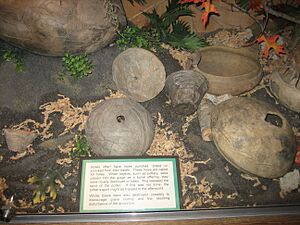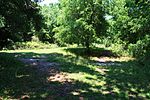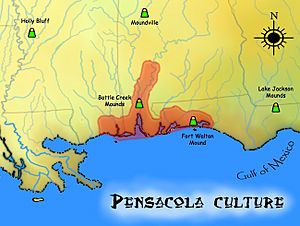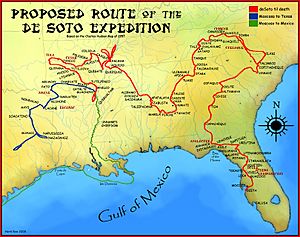Pensacola culture facts for kids
The Pensacola culture was a group of Native American people who lived along the Gulf Coast of the United States. They were part of the larger Mississippian culture. This culture existed from about 1100 to 1700 CE. Their lands stretched from Choctawhatchee Bay in Florida to the Mississippi River Delta near Biloxi, Mississippi. Many of their important sites were around Mobile Bay in the Mobile–Tensaw River Delta. Their influence also reached inland, north into the Tombigbee River and Alabama River valleys, up to Selma, Alabama.
Contents
What Was the Pensacola Culture?

The Pensacola culture and the nearby Fort Walton culture grew from earlier groups. They combined the local Weeden Island culture from the Woodland period with new ideas. These new ideas came from Mississippian people moving in from the north.
At first, experts thought Pensacola and Fort Walton were the same. They named them after sites near Pensacola Bay. But later studies showed they were different. Their pottery styles were a key difference. Researchers also found that the Bottle Creek site was the main center for the Pensacola culture. This site is north of Mobile Bay.
Connections and Lifestyle
Early Pensacola people had strong ties to the Moundville Archaeological Site. This important site was located upstream from them. Pensacola pottery often used crushed shell as a temper. This was common in Mississippian pottery.
The Fort Walton people, however, were more connected to the Etowah Indian Mounds in Georgia. Their pottery used sand, grit, or grog as temper. Pensacola culture also had contact with Plaquemine culture people. These groups lived in the Lower Mississippi Valley.
Studies at the Bottle Creek site suggest the Pensacola people moved into the area from the north and west. By the 1300s, they had their own unique pottery and way of settling. Unlike their Fort Walton neighbors, Pensacola people used more coastal resources. They relied less on growing maize (corn).
The Pensacola area likely had many small chiefdoms. Each had its own local center, like Fort Walton Mound. But the Bottle Creek site was the largest and most powerful center. It was the biggest site on the Gulf Coast. It had 18 mounds, similar to Moundville. By 1250 CE, Pensacola people traded with Coastal Coles Creek culture groups. Their pottery style even influenced people in southeastern Louisiana.
Pensacola Culture Timeline
Here is a simple timeline of the Pensacola culture:
| Period | Culture | Dates | Bottle Creek site phases |
|---|---|---|---|
| (Early) Late Woodland | Weeden Island culture | 400 - 750 CE | Tate's Hammock |
| (Late) Late Woodland | Wakulla culture | 750 - 1100 CE | Coden |
| Early Mississippian | Pensacola culture | 1100 - 1250 CE | Andrews Place |
| Middle Mississippian | Pensacola culture | 1250 - 1400 CE | Bottle Creek I |
| Late Mississippian | Pensacola culture | 1400 -1550 CE | Bottle Creek II |
| Protohistoric | Pensacola culture | 1550 - 1700 CE | Bear Point |
Important Archaeological Sites
Here are some key sites where archaeologists have learned about the Pensacola culture:
| Site | Image | Description |
|---|---|---|
| Bottle Creek Indian Mounds |  |
This site is on a swampy island in the Mobile-Tensaw River Delta. It is the main site for the Pensacola culture. People lived here between 1250 and 1550 CE. It was a major meeting point for different Mississippian groups. The site has 18 platform mounds. The tallest mound is about 45 feet (14 meters) high. Five mounds are around a central open area called a plaza. It was the largest Mississippian chiefdom on the northern Gulf Coast. |
| Butcherpen Mound | This site is in Santa Rosa County, Florida. It is mostly linked to the Weeden Island culture. Carbon dating shows it was used around 1005 CE. However, some Pensacola era pottery has also been found there. | |
| Dauphin Island Mound |  |
This mound is on the northern shore of Dauphin Island, Alabama. It is a midden mound made of discarded oyster shells. Experts think people from Bottle Creek came here in winter. They harvested the rich sea life in the sound. |
| Fort Walton Mound |  |
This is a very large platform mound in Okaloosa County, Florida. It is 12 feet (3.7 meters) high and 223 feet (68 meters) wide at its base. It was once thought to be the main site for the Fort Walton culture. But more studies showed it belonged to the Pensacola culture. |
| Hickory Ridge Cemetery Archeological Site | This site is in Escambia County, Florida, north of Big Lagoon. It was a cemetery for a nearby village. Carbon dating shows it was used around 1450 CE. Pottery found here suggests it was from a later phase of the Pensacola culture. | |
| Naval Live Oaks Cemetery | Also known as the Head Site, this was a prehistoric cemetery. It is now located in Santa Rosa County, Florida. |
Contact with Europeans
Archaeological digs at the Bottle Creek site show people lived there when Europeans arrived. This was from the 1500s to the early 1700s. We are not sure which specific Native American groups these people were.
The Pensacola culture people might have first met Europeans in 1528. This was when the Narváez expedition explored the area. Álvar Núñez Cabeza de Vaca was with this group. He wrote that the Native Americans near Pensacola Bay were "large and well formed." They lived in permanent houses. The chief wore a robe of fine animal skins. After seeming friendly, they attacked the Spanish at night.
In 1539, Diego Maldonado explored the Gulf Coast for Hernando de Soto. He found Pensacola Bay, which the Spanish called the Bay of Achuse. Maldonado found a village there. He took one or two people and a "good blanket of sables." De Soto told Maldonado to bring supplies to the Bay of Achuse the next summer. Maldonado returned for three years, but de Soto never showed up.
It is possible that the Pensacola culture people were connected to the Mabilians. De Soto had a terrible encounter with the Mabilians in 1540. Later, in 1674, a bishop named Gabriel Diaz Vara Calderon mentioned the Mabilians. He placed them on an island in west Florida. This might have been Mound Island, where the Bottle Creek site is. The city of Mobile, Alabama was later named after them.
In 1559, Tristán de Luna y Arellano tried to start a Spanish colony. It was called Ochuse, on Pensacola Bay. But the colony did not last long. The Spanish hoped to get food from the local people. However, they found the area mostly empty. Only a few people lived in fishing camps around the bay.
By the early 1700s, the Pensacola people lived in western Florida. They spoke a Muskogean language. They were linked to the Fort Walton culture. The name Pensacola Bay and the city of Pensacola come from them. These people lived in the area until the mid-1700s. By 1764, they had joined other groups. These included the Choctaw or Creek people. Some moved west with the Biloxi people to join the Tunica people.
See also
 In Spanish: Cultura Pensacola para niños
In Spanish: Cultura Pensacola para niños




